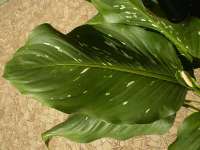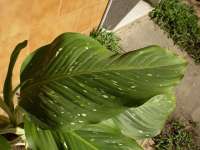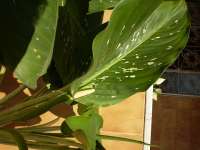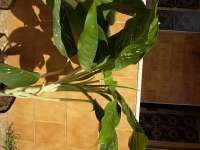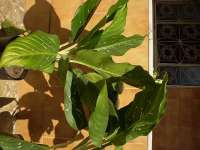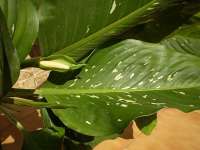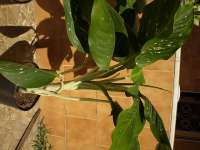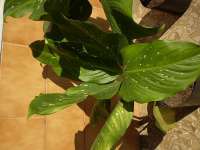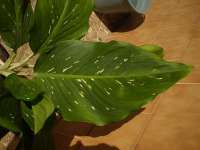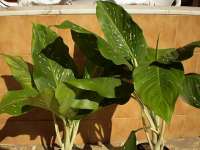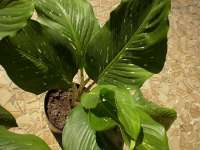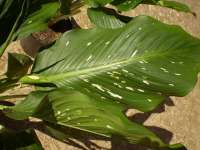 IAS on Facebook IAS on Facebook
 IAS on Instagram IAS on Instagram

|

IAS Aroid Quasi Forum
About Aroid-L
This is a continuously updated archive of the Aroid-L mailing list in a forum format - not an actual Forum. If you want to post, you will still need to register for the Aroid-L mailing list and send your postings by e-mail for moderation in the normal way.
|
Dieffenbachia
| |
|
From: criswick at spiceisle.com (criswick) on 2007.09.05 at 22:05:03(16222)
Marcus,
I would not have thought it is D. picta. For one thing it has white
petioles, whereas I believe that those of D. picta are green speckled with
white. Also the leaf blade shape is wrong. Can't suggest what sp. this is,
though, although it looks familiar.
John Criswick.
| +More |
-----Original Message-----
From: aroid-l-bounces at gizmoworks.com [mailto:aroid-l-bounces at gizmoworks.com]
On Behalf Of Marcus Nadruz
Sent: Wednesday, September 05, 2007 12:12 PM
To: aroid-l at gizmoworks.com
Subject: [Aroid-l] Dieffenbachia
Hi fellows
I would like to request help of you to confirm this species is Dieffenbachia
picta.
Thank you
Marcus Nadruz
|
|
From: chammer at cfl.rr.com (Bluesea) on 2007.09.06 at 03:43:09(16225)
My D. 'Sao Antonio' are smaller than this, but they do have similar leaf
markings with white petioles.
Russ
| +More | |
central Fla
criswick wrote:
> Marcus,
>
> I would not have thought it is D. picta. For one thing it has white
> petioles, whereas I believe that those of D. picta are green speckled with
> white. Also the leaf blade shape is wrong. Can't suggest what sp. this is,
> though, although it looks familiar.
>
> John Criswick.
>
> -----Original Message-----
> From: aroid-l-bounces at gizmoworks.com [mailto:aroid-l-bounces at gizmoworks.com]
> On Behalf Of Marcus Nadruz
> Sent: Wednesday, September 05, 2007 12:12 PM
> To: aroid-l at gizmoworks.com
> Subject: [Aroid-l] Dieffenbachia
>
> Hi fellows
>
> I would like to request help of you to confirm this species is Dieffenbachia
> picta.
> Thank you
>
> Marcus Nadruz
>
>
>
> _______________________________________________
> Aroid-L mailing list
> Aroid-L at www.gizmoworks.com
> http://www.gizmoworks.com/mailman/listinfo/aroid-l
>
>
-------------- next part --------------
An HTML attachment was scrubbed...
URL: http://www.gizmoworks.com/mailman/private/aroid-l/attachments/20070905/006e1bd9/attachment-0001.htm
|
|
From: abri1973 at wp.pl (Marek Argent) on 2007.09.06 at 06:30:30(16226)
I agree w ith John Criswick, that P. picta = D. maculata has geen stem & petioles.
Marek Argent
| +More |
----- Original Message -----
From: Marcus Nadruz
To: aroid-l at gizmoworks.com
Sent: Wednesday, September 05, 2007 6:12 PM
Subject: [Aroid-l] Dieffenbachia
Hi fellows
I would like to request help of you to confirm this species is Dieffenbachia picta.
Thank you
Marcus Nadruz
__________ NOD32 Informacje 2507 (20070905) __________
Wiadomosc zostala sprawdzona przez System Antywirusowy NOD32
http://www.nod32.com lub http://www.nod32.pl
------------------------------------------------------------------------------
------------------------------------------------------------------------------
------------------------------------------------------------------------------
------------------------------------------------------------------------------
------------------------------------------------------------------------------
------------------------------------------------------------------------------
------------------------------------------------------------------------------
------------------------------------------------------------------------------
------------------------------------------------------------------------------
------------------------------------------------------------------------------
------------------------------------------------------------------------------
------------------------------------------------------------------------------
------------------------------------------------------------------------------
_______________________________________________
Aroid-L mailing list
Aroid-L at www.gizmoworks.com
http://www.gizmoworks.com/mailman/listinfo/aroid-l
-------------- next part --------------
An HTML attachment was scrubbed...
URL: http://www.gizmoworks.com/mailman/private/aroid-l/attachments/20070906/b60c5f6d/attachment-0001.htm
|
|
From: "John Criswick" <criswick at spiceisle.com>
on 2014.11.08 at 17:20:21(23151)
Here in Grenada the native Dieffenbachia species is D. seguina.
I perhaps would not have thought very much about this were it not for the fact that Grenadians call these wild dieffenbachias, “seguin”, pronounced “siggin”. I’m aware that the name Seguina could be a surname, and the species simply named after someone with that surname. But if that were the case, it is hardly likely that this surname would have entered the vocabulary of the French patois-speaking planters and slaves of Grenada.
Therefore I am wondering what is the significance of this specific name “seguina” and also why do Grenadians call dieffenbachias “siggin”. Is anyone able to supply this information please?
John Criswick.
| HTML +More |
------=_NextPart_000_000A_01CFFB35.3A8336F0--
--==============Q51703812605782099==
|
|
From: Jason Hernandez <jason.hernandez74 at yahoo.com>
on 2014.11.10 at 05:28:05(23156)
According to Wiktionary:
Seguine (Italian): Compound of imperative (tu form) of seguire and ne.
And Seguire (Italian): (transitive) to follow or pursue. From Vulgar Latin root *sequire, from Latin sequī, present active infinitive of sequor.
And Ne (Italian): of it or of them.
In Spanish, I think of "proseguir," with the same meaning: lo prosigas, (imperative, tu form) "pursue it."
On the other hand, Wikipedia explains the surname Seguin:
Seguin is a French and Gascon name. It is of Germanic origin (sig-, that is, "victory", cf. modern German Sieg, and -win, that is, "friend", related to modern English "win").
I do know that sometimes local names in languages derived from Latin sound very much like the Latin name of the plant; one that comes readily to mind is Urtica (the genus of stinging nettle), and ortiga (the Spanish word for stinging nettle). But that usually only happens with genera, not specific epithets. On the other hand, sometimes early taxonomists would take a local vernacular name for a plant and incorporate it into the scientific name; if the plant was already called seguin for some reason, then Schott (who described it) may have used that existing name as the specific epithet. If you can find his original description, he may explain it.
Clear as mud?
Jason Hernandez
| HTML +More | |
Naturalist-at-Large
Date: Sat, 8 Nov 2014 09:20:21 -0800
From: "John Criswick"
Subject: [Aroid-l] Dieffenbachia
To: "Discussion of aroids"
Message-ID:
Content-Type: text/plain; charset="us-ascii"
Here in Grenada the native Dieffenbachia species is D. seguina.
I perhaps would not have thought very much about this were it not for the
fact that Grenadians call these wild dieffenbachias, "seguin", pronounced
"siggin". I'm aware that the name Seguina could be a surname, and the
species simply named after someone with that surname. But if that were the
case, it is hardly likely that this surname would have entered the
vocabulary of the French patois-speaking planters and slaves of Grenada.
Therefore I am wondering what is the significance of this specific name
"seguina" and also why do Grenadians call dieffenbachias "siggin". Is
anyone able to supply this information please?
John Criswick.
------=_Part_174304_1029785321.1415597285990--
--=============='65574360733097631==
|
|
From: Corey W <cewickliffe at gmail.com>
on 2014.11.10 at 13:41:13(23157)
I wouldn't be surprised that it is actually based off that word, and all sources I could quickly find listed its meaning as obscure, with one mentioning it could be based off "seguin" as you suggested.
The answer may be in the original description, but that is from 1760 as Arum sequine Jacq. Even if it didn't completely describe the etymology it may say if the original description was of a plant from a specific set of islands, like Grenada, in which case you may have as direct an answer as you will get.
I don't have a chance to look, but there may be a copy of that description scanned somewhere on the internet. I've found scans from a similar period for other species so not impossible, especially as more herbariums are print their catalogs online.
Reading the lesson description may be a whole other set of issues though ;)
Corey
| HTML +More |
On Nov 8, 2014 9:44 PM, "John Criswick" wrote:
Here in Grenada the native Dieffenbachia species is D. seguina.
I perhaps would not have thought very much about this were it not for the fact that Grenadians call these wild dieffenbachias, “seguin”, pronounced “siggin”. I’m aware that the name Seguina could be a surname, and the species simply named after someone with that surname. But if that were the case, it is hardly likely that this surname would have entered the vocabulary of the French patois-speaking planters and slaves of Grenada.
Therefore I am wondering what is the significance of this specific name “seguina” and also why do Grenadians call dieffenbachias “siggin”. Is anyone able to supply this information please?
John Criswick.
_______________________________________________
Aroid-L mailing list
Aroid-L@www.gizmoworks.com
http://www.gizmoworks.com/mailman/listinfo/aroid-l
--047d7bb70942e93d090507815043--
--==============�34537754482297341==
|
|
From: "John Criswick" <criswick at spiceisle.com>
on 2014.11.11 at 11:16:06(23161)
Thank you very much for that information. I should like to know from which island the collection was made.
John.
From: aroid-l-bounces@www.gizmoworks.com [mailto:aroid-l-bounces@www.gizmoworks.com] On Behalf Of Corey W
| HTML +More |
Sent: Monday, November 10, 2014 5:41 AM
To: Discussion of aroids
Subject: Re: [Aroid-l] Dieffenbachia
I wouldn't be surprised that it is actually based off that word, and all sources I could quickly find listed its meaning as obscure, with one mentioning it could be based off "seguin" as you suggested.
The answer may be in the original description, but that is from 1760 as Arum sequine Jacq. Even if it didn't completely describe the etymology it may say if the original description was of a plant from a specific set of islands, like Grenada, in which case you may have as direct an answer as you will get.
I don't have a chance to look, but there may be a copy of that description scanned somewhere on the internet. I've found scans from a similar period for other species so not impossible, especially as more herbariums are print their catalogs online.
Reading the lesson description may be a whole other set of issues though ;)
Corey
On Nov 8, 2014 9:44 PM, "John Criswick" wrote:
Here in Grenada the native Dieffenbachia species is D. seguina.
I perhaps would not have thought very much about this were it not for the fact that Grenadians call these wild dieffenbachias, “seguin”, pronounced “siggin”. I’m aware that the name Seguina could be a surname, and the species simply named after someone with that surname. But if that were the case, it is hardly likely that this surname would have entered the vocabulary of the French patois-speaking planters and slaves of Grenada.
Therefore I am wondering what is the significance of this specific name “seguina” and also why do Grenadians call dieffenbachias “siggin”. Is anyone able to supply this information please?
John Criswick.
_______________________________________________
Aroid-L mailing list
Aroid-L@www.gizmoworks.com
http://www.gizmoworks.com/mailman/listinfo/aroid-l
------=_NextPart_000_00A3_01CFFD5D.D6249020--
--==============…59036349408548130==
|
|
From: Jason Hernandez <jason.hernandez74 at yahoo.com>
on 2016.07.10 at 09:01:56(23662)
" I may not have fully understood if it was being suggested they might be the same thing/plant/drink."
No. I was giving them as two different examples of plants whose Native American names were adopted by white settlers who had no name of their own for the plant.
Now, re: seguin. The Arawak language of the Caribbean is lost, except for a partial word list compiled from Spanish colonial records. If it should be that seguin was borrowed from that language, it may not be possible to find out what it meant -- if, indeed, it ever meant anything other than that particular kind of plant. I have to add that last caveat because, well, asking what a plant common name means is rather like asking what the word "maple" means. It may be an understandable question for someone from a country where maples do not grow, but the only answer is that "maple" means that particular kind of tree. It has no other meaning.
Okay, I was pretty sure this subject had been discussed before, but now that I search the Aroid-L archives, I can't find it.
Jason Hernandez
| HTML +More | |
Naturalist-at-Large
------=_Part_1424470_641668814.1468141316860--
--==============Y05574590108643378==
|
| |
Note: this is a very old post, so no reply function is available.
|
|



